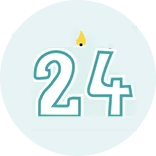23-month Milestones: Your Wilful Toddler
As your little one continues to grow up fast, looking at his baby photos will make you realise how much he’s changed. He has started looking less like a chubby baby that he used to be once, and he’s also becoming more independent by the day.
This month may bring along challenges of picky eating or the transition to a toddler bed. Read on to learn how you can handle these and know what else lies in store.
Enjoy this last month before your one-year-old turns two. Wow, time flies!
23 Months Baby Development Milestones
Although each toddler develops at her own pace, these are some of the 23-month milestones you may see your baby reach around this time:
Taking the stairs:
You may notice that your 23-months-old baby may be able to walk up and down the stairs. To keep your child safe, continue to use baby gates at the top and bottom of the stairs; you may need these until your little one turns three. Always supervise your little one around the stairs.
Better hand and finger skills:
For example, she may be able to scribble, turn over containers to pour their contents out, or even build a tower of four blocks or more.
Showing a preference for her left or right hand:
Your toddler may show a tendency for using her left or right hand, but keep in mind that many children tend not to display a definite preference for some years to come or may even be ambidextrous. Either way, it’s best not to pressure your little one into using one hand over the other.
May say simple phrases:
You may hear your toddler utter a few simple sentences. She may even start to use the correct names for people she knows, body parts, or objects. As with all the other milestones, language development is not set in stone, so be patient if this doesn’t describe your toddler’s speech just yet.
Looking less like a chubby baby:
As your little one gets further into toddlerhood, you’ll notice she may be gaining muscle and becoming taller and leaner, and that her jawline may be more defined.
Support Your 23-Month-Old’s Development
You can encourage the development of your baby at 23 months in many ways. Here are a few ideas:
Help her improve hand and finger skills:
You can help your 23-month-old get better at using her hands and fingers with a few little games like folding colourful paper together, putting blocks into the corresponding holes, stacking blocks, creating shapes with clay, or doing some finger painting.
Organise playdates with slightly older children:
You may notice your little one is more enthusiastic around other people and enjoys the company of other toddlers, so help encourage her social development by organising playdates with children her age or those who are slightly older. Just be prepared to step in if any conflict arises, like if your toddler tries to hit or push another child or the other child is also physically aggressive.
Teach her self-care skills:
This is a good age to start teaching your toddler how to brush her own hair and dress herself. She may be excited to do these all by herself, but she’ll still need your help at this age.
Set consistent boundaries:
Your toddler is likely to act on impulse, which is why having boundaries and setting limits is important. Clearly explain your expectations and prioritise praising her good behaviour over punishing bad behaviour. Be consistent with enforcing boundaries while keeping realistic expectations. At this age, your little one may not understand or be able to follow complex instructions and hasn’t yet mastered self-control.
Set a good example:
Children watch everyone around them, so try to set a good example and explain concepts like sharing. For example, if you cut an apple in half and give half to your little one, explain that you are sharing with her and mention how nice it is for people to share.
Think about potty training:
Have you noticed any signs of potty-training readiness? These include things like your little one showing interest in learning to use the potty, being able to keep her diaper dry for a couple of hours during the day or saying that she has to go. If you've spotted some of these signs, pick up tips on how to potty train and get the supplies you’ll need, like a potty chair.
Let him lead when you read:
Your toddler has a mind of his own, so take advantage of this independent spirit when you read together. Let him pick the book he wants from a selection of three or four that you put together and compliment him on making a good choice. As you start reading together, let him be the page-turner-in-chief. Ask him questions about what's coming next in the story or ask for his help in finding something on a page. If the book contains a rhyme or a phrase that's repeated, stop when you get to it and give him the opportunity to chime in, expressing your pride and delight when he does.
Your Baby's Development: Mealtimes and Menus
To keep your active 23 months baby going, she needs to have a variety of healthy foods that can come from about three meals and two snacks each day. Worry not if your toddler eats more one day and then skips a meal or snack on another. You can offer her foods like vegetables, fruits, whole grains, dairy products (milk and yoghurt), and proteins (meat and eggs) to make sure she gets all the nutrients necessary for her growth.
Handling Picky Eaters
From time to time, you may feel a little stressed out trying to get your little one to eat her greens or try new foods. You might also become frustrated when your toddler stops wanting to eat something she loved just a few days ago.
Here are a few things you can try that may help you and your child get through the picky eating stage:
Eat together as a family:
Sit down together at the table without distractions like the TV or phones. Give your little one the same foods that you are eating but try to include a dish you know she likes.
Avoid pushing food or meals:
If your little one refuses a meal, don’t force it or create a fuss over it. Your toddler knows her body and will eat when she is hungry. Pressuring her to eat something she doesn’t want to may backfire in the long run by making her dislike that food even more.
Don’t bribe your child:
It may be tempting to bribe your child with sweets or dessert to get her to eat her greens, but this can lead to more battles at the dining table, as well as setting the stage for unhealthy eating patterns and even obesity.
Keep trying:
She may refuse to take a bite at first, but don’t give up. It can take a while for her to get accustomed to certain flavours, smells, or textures, so offer a new food at least several times, waiting a while in between tries.
Offer variety:
As you plan your family's meals, introduce some new foods or flavours for her to explore, or even serve a different form of a familiar dish—prepare frozen corn instead of fresh corn, for instance. You never know when your child might be willing to try something, and this is a good way to encourage her to broaden her palate.
Make dishes fun:
Toddlers love trying eye-catching food, so make the plating fun. For example, create a smiley face using fruits and vegetables. Celery sticks can be the smile, a wedge of apple the nose, a few raisins the eyes, and some short carrot sticks can be the hair. Dips are another good choice, as your toddler will love making a little mess by sticking carrot sticks in a yummy sauce. If your little one is having fun in her high-chair, you’ll find she’s more likely to eat the food you present her.
Get your little one involved in the cooking:
Cooking together with you is exciting, especially when she gets to add her own creative touches, and she's more likely to enjoy eating something she's helped to make. Ask her to help with tasks such as washing fruits and vegetables, picking herbs, measuring ingredients, and stirring and pouring batter, all under your watchful eye.
Introduce similar foods:
If your little one likes sweet potato, why not have her try squash? She may have a favourite ingredient similar to a new one you can use as a bridge to try something new.
Pair familiar and unfamiliar foods:
If your toddler loves cheese, grate a little bit on broccoli or cauliflower. Or serve a new vegetable with a dip she loves to make things a bit more fun and familiar.
Sleep Schedule for 23-Month-Old Toddlers
Your 23-month-old toddler needs approximately 11 to 14 hours of sleep per day. At this age, though, she’ll likely only need one afternoon nap.
Around this age, you may notice that your little one tries to climb out of her crib, and you may wonder whether you need to move her to a bed.
Transitioning to a Bed
It may be several months away, but it’s a good idea to think about when you might need to transition your little one to a low toddler bed.
For your little one’s safety, here are a few things to keep in mind around this time:
Adjust the crib mattress to the lowest possible setting:
If your toddler is trying to climb out of the crib, a lower mattress may keep her in place for a little longer. Check what mattress settings the crib you have offers by reading the manufacturer’s guidelines.
Start with the mattress:
When you think it’s time to make the transition to a bed (remember, it could still be months away), you might prefer to place a larger mattress on the floor or onto a low bedframe instead of moving your toddler to a normal-height single bed, for example.
Use a siderail on the bed:
Once you've switched to a bed, you may want to use a siderail to keep your toddler in place at night. Some cribs convert to a toddler bed and give you the option of keeping a siderail in place. See what configurations your crib offers, if any, by checking the instructions.
Consider a baby gate:
Your little one may want to get out of bed and walk over to your room at night, or wander around the house, so you might like to install a baby gate she can’t scale to keep her safe.
A Day in the Life of Your Toddler
Now that you have an active toddler running around, here’s a look at what a day in your home might look like:
Common Childhood Symptoms and Illnesses
Despite your best efforts to keep your little one healthy, at some point it's likely that he'll come down with a cold, earache, or tummy trouble. Here are some of the most common childhood symptoms and illnesses, along with what you can do to make things easier for your child:
Sore throat:
This can range from scratchiness to extreme pain and may be accompanied by a fever or swollen glands. A sore throat caused by a virus doesn’t need antibiotics and will go away in about 7 to 10 days. You can help ease the discomfort by giving him warm liquids to drink. Strep throat, which is caused by bacteria, is rare in toddlers, but if you think your toddler has this see your doctor, as this requires antibiotics. Symptoms of strep throat include sore throat, fever, headache, stomach pain, nausea, and vomiting.
Earache:
Pain in the ear is common among children and can be caused by things like an ear infection or pressure from a cold, among others. Take your toddler to your doctor to find out the cause and get advice about treatment. If your doctor says it’s OK, you may be able to give your toddler acetaminophen or ibuprofen to help relieve the pain.
Common cold:
Colds are caused by viruses, and during the first two years of life most children catch 8 to 10 colds. The common cold is due to a virus and can last for up to 10 days, though some symptoms, such as coughing, may last longer. You can make the symptoms a little easier for your little one by making sure he is comfortable, gets plenty of rest, and drinks plenty of liquids. If your doctor says it’s OK, you can use nasal spray to help with a stuffed nose.
Urinary tract infection:
Also known as a UTI, this infection can lead to discomfort in the abdomen and bladder area and can cause pain or a burning sensation when peeing. Your toddler’s doctor will need to take a urine sample before recommending a course of treatment.
Bronchiolitis:
This common respiratory infection causes the breathing tubes in the lungs to swell, making it hard for infants to breathe. It is often caused by a virus during cold and flu season and cannot be treated with antibiotics. If you notice your little one is showing signs of troubled breathing, call your doctor. Your doctor may recommend treatments like saline drops or acetaminophen to help relieve the symptoms until the infection is gone.
Bacterial sinusitis:
As you may guess from the name, this infection comes from bacteria trapped in the sinuses. Symptoms can last for more than 10 days and are similar to those of a cold, with a runny nose and a cough. If bacterial sinusitis is diagnosed, your toddler’s doctor may prescribe antibiotics.
Tummy Problems and Diarrhoea
Although you don't have to necessarily worry about an occasional loose stool, watery stools that occur more often than usual could mean that your little one has diarrhoea. Diarrhoea can be caused majorly due to:
Viruses:
Viruses are common factors that can cause diarrhoea in toddlers. Among different viruses, rotavirus causes watery diarrhoea in babies and toddlers. Your baby will be given a vaccine for severe rotavirus diarrhoea.
Bacteria:
Food contaminated with bacteria can cause food poisoning of which diarrhoea is a major symptom.
Food allergies:
Your little one may be allergic to certain foods or lactose intolerant.
Infections:
Infections that occur in the urinary infection or respiratory tract, the inner ear, can have diarrhoea as one of their symptoms.
Drinking fruit juice:
Drinking a lot of fruit juice can also cause watery stools.
Side effects of oral medication:
Diarrhoea can often happen by taking antibiotics.
Diarrhoea can lead to dehydration, so if your toddler experiences diarrhoea, consult his doctor for over-the-counter electrolyte solution recommendation that can help replace the lost fluids.
FAQs at a Glance
Around this age, your little one may be able to follow simple instructions, imitate certain actions or words, push a wheeled toy, and use two-word sentences. However, each child develops at his own rate, so don’t be surprised if your little one cannot do some of these things yet.
If you have any concerns, talk to your doctor.
Your Life as a Parent: Arrival of a New Baby
It's normal to wonder how your 23-month-old will handle the arrival of your newborn baby in your home. Your toddler may feel a little jealous because of the lack of attention, which he once received.
Due to the fear of feeling a little left out, he may throw a tantrum or misbehave to get a reaction from you. For him, even negative attention would be a win in such situation. He may prefer your anger rather than your ignorance as you focus more on preparing for your newborn.
Here's how you can make things easier for your little one:
Don’t hide anything:
As your toddler will be curious about your pregnancy, it's okay to tell him that a new baby is coming.
Avoid emphasising on getting a little brother or sister:
Using these words with your toddler may mislead him. He may assume that you'll be bringing home a new playmate his age rather than a baby.
Be matter of fact about the new baby's arrival:
Your toddler may be concerned about the events that happen in the immediate future. So, it’s alright to let him know about another baby coming but avoid making a big deal about it or the focus of daily life.
Either move your toddler into his own room or prepare the room for two:
If you’re planning separate rooms for your kids, it’s best to have your toddler’s room ready before your delivery. This way, your elder child can transition to his personal room before the newborn’s arrival. It will reduce changes and chaos happening all at once. Otherwise, you can make space for the new crib and allot the rest of the room to your toddler.
Include your toddler in most of the activities:
Once you bring home your newborn, let your toddler get involved with the new baby as much as possible. This way, he will feel included - you can ask him to help out with dressing the baby, or with feeding or bathing. But, avoid leaving your toddler alone with the newborn.
Schedule quality time with your toddler:
Both of you try spending quality one-on-one time with your toddler. This way, he won't feel like all the attention is on the new baby. The best time to spend time would be when your newborn is napping.





